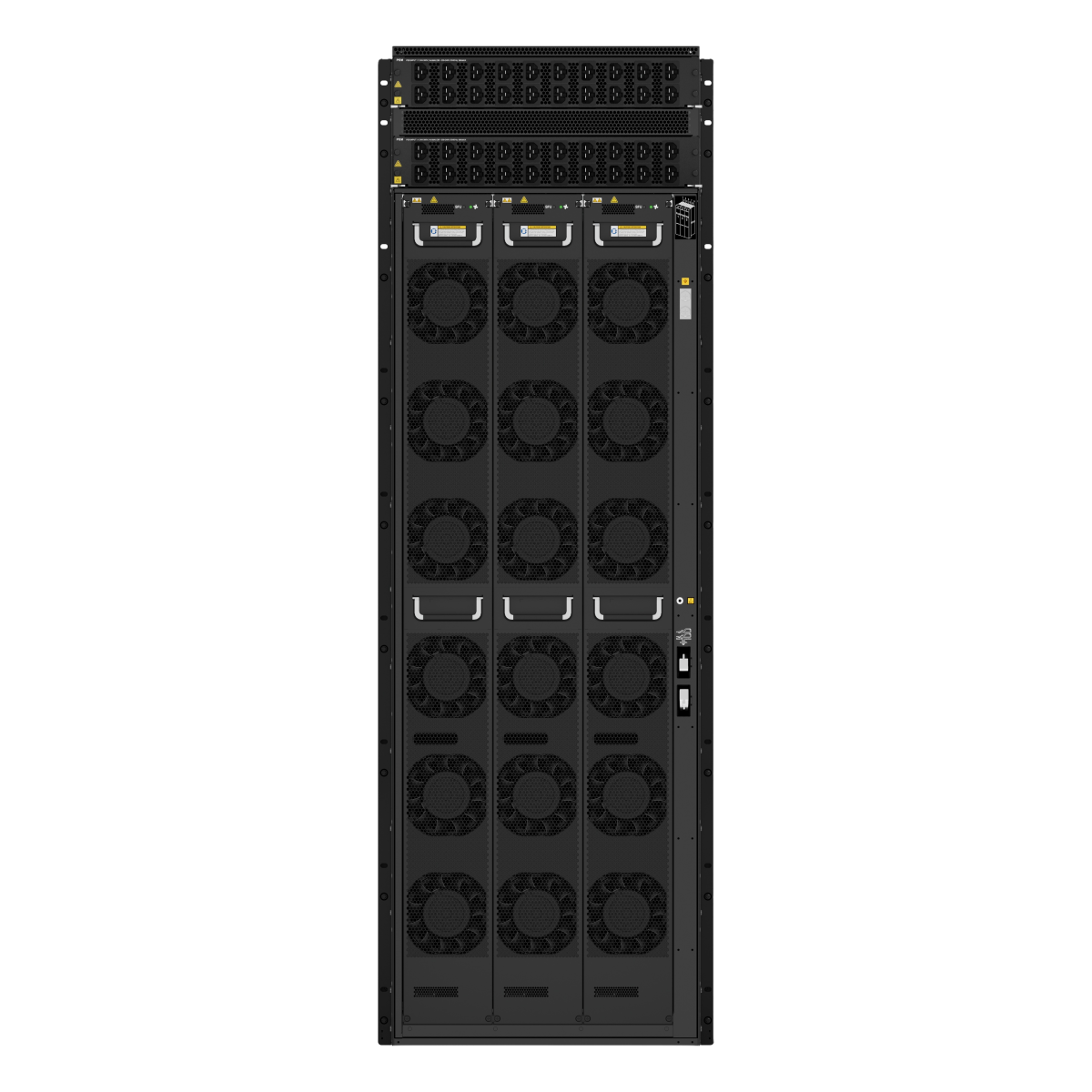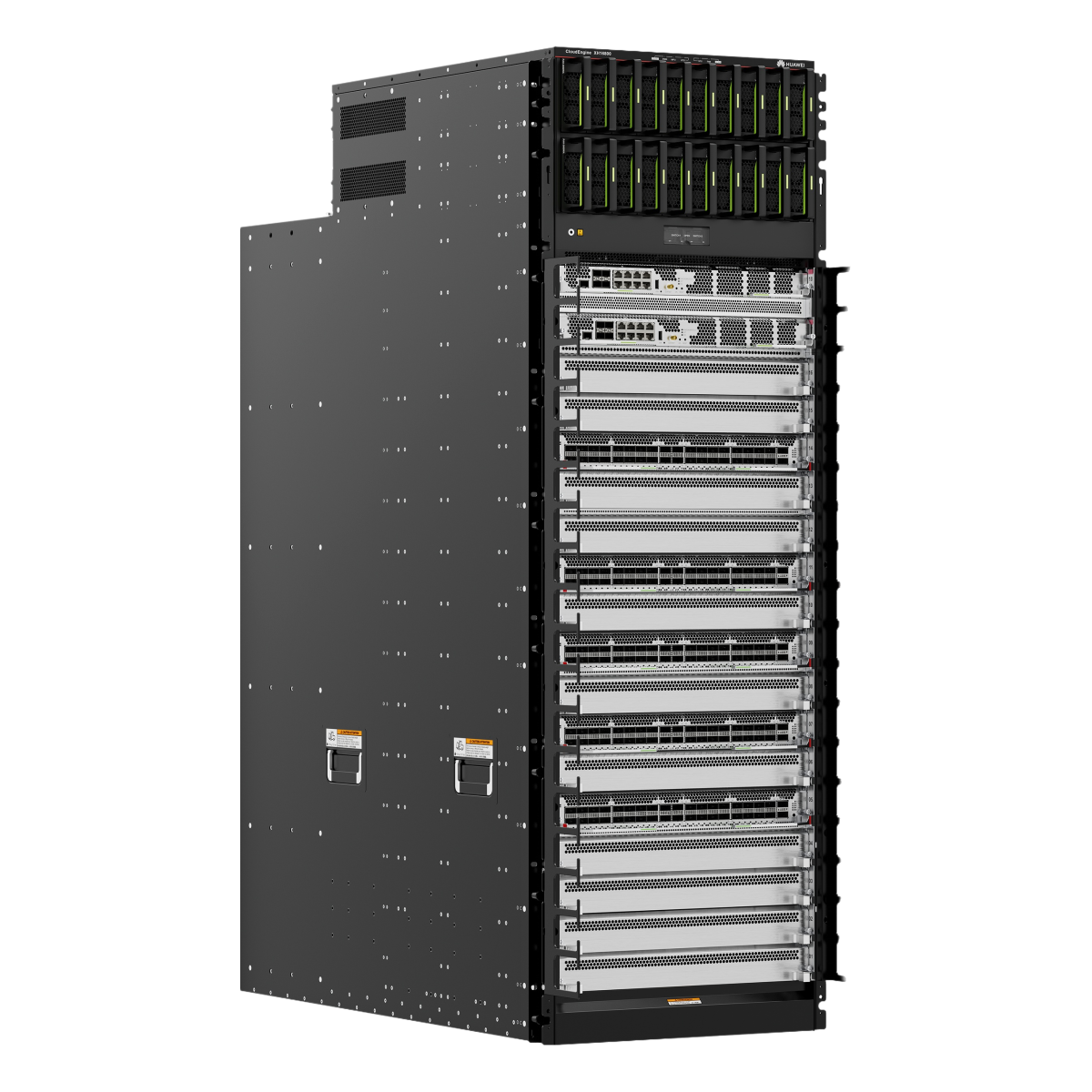XH16800-16 AC/HVDC assembly chassis
Condition: NOB
RMA Warranty
Description
A data center switch built for the intelligent era, powered by a unique iLossless algorithm that learns and trains network-wide traffic in real-time, achieving zero packet loss and E2E μs latency and maximizing throughput.
| Basic Information | |
| Description | XH16800-16 AC/HVDC assembly chassis |
| Part Number | 02355YPJ |
| Model | XH16800-16-AH |
| First supported version | V300R023C10 |
| Technical Specifications | |
| Dimensions with packaging (H x W x D) [mm (in.)] | 1695 x 770 x 1350 (66.73 x 30.31 x 53.15) |
| Dimensions without packaging (H x W x D) [mm (in.)] | – 1436 mm x 442 mm x 1033 mm (56.54 in. x 17.40 in. x 40.67 in.), dimensions of the chassis body – 1436 mm x 483 mm x 1144 mm (56.54 in. x 19.02 in. x 45.04 in.), including mounting brackets and cable management frames |
| Weight without packaging [kg (lb)] | 262.8 kg (579.47 lb) (including two MPUs and filler panels) |
| Weight without packaging (full configuration) [kg (lb)] | 742 kg (1635.81 lb), fully configured with XH-L36DQ2CQJ2 cards and including optical modules |
| Weight with packaging [kg (lb)] | 335 kg (738.54 lb) |
| Cabinet installation standards | – A812 – A612 |
| Chassis height [U] | 32.3 |
| Switching capacity | To obtain data of this specification item, see the corresponding datasheet or contact the product sales personnel. |
| Redundant MPUs | 1: 1 |
| Redundant Switch fabrics | N+M |
| Power supply mode | AC,HVDC |
| Number of power modules | 20 |
| Redundant power supply | – Dual-input power supply system: N+1 backup is recommended. – Single-input power supply system: N+1 backup Dual-input power supply is recommended to ensure reliability. |
| Rated input voltage [V] | – AC: 220 V; 50 Hz/60 Hz – High-voltage DC (HVDC): 240 V/380 V |
| Input voltage range [V] | – AC: 176–290 V; 45–65 Hz – High-voltage DC (HVDC): 188 V to 288 V or 260 V to 400 V |
| Maximum input current [A] | – AC: 16 A @ 200 V; 18.5 A @ 176 V – High-voltage DC (HVDC): 18 A @ 188 V; 13 A @ 260 V |
| Maximum output power [W] | – In 19+1 backup mode: 3000 W x 19 = 57000 W – In 20+0 backup mode: 3000 W x 20 = 60000 W |
| Certification | – Compliance with safety standards – Compliance with EMC standards – Compliance with environment and environmental protection standards |
| Redundant fans | Fan modules work in hot standby mode. At the normal temperature range, the system can operate normally for a short period if a single fan module fails. You are advised to replace the faulty fan module immediately. |
| Heat dissipation mode | Heat dissipation using fans |
| Airflow direction | Front-to-back |
| Availability | 0.9999970745 |
| MTBF [year] | 32.68 years |
| MTTR [hour] | 1 hour |
| Number of LPU slots | 16 |
| Number of MPU slots | 2 |
| Number of SFU slots | 9 |
| Number of slots | 27 |
| Long-term operating altitude [m (ft.)] | ≤ 5000 m (16404 ft.) When the altitude is between 1800 m and 5000 m (5906 ft. and 16404 ft.), the highest operating temperature reduces by 1°C (1.8°F) every time the altitude increases by 220 m (722 ft.). |
| Long-term operating relative humidity [RH] | 5% RH to 85% RH, noncondensing |
| Long-term operating temperature [°C (°F)] | 0°C to 40°C (32°F to 104°F) |
| Storage altitude [m (ft.)] | ≤ 5000 m (16404 ft.) |
| Storage relative humidity [RH] | 5% to 95% RH, non-condensing |
| Storage temperature [°C (°F)] | -40ºC to +70ºC (-40°F to +158°F) |
| Ethernet Switching>Eth-Trunk | |
| IEEE 802.3ad | Y |
| Ethernet Switching>STP/RSTP/MSTP | |
| Loop prevention | Y |
| IEEE 802.1w(RSTP) | Y |
| IEEE 802.1s(MSTP) | Y |
| Root protection | Y |
| BPDU protection | Y |
| IEEE 802.1d (STP) | Y |
| Ethernet Switching>VBST>VBST function | |
| VBST | Y |
| Ethernet Switching>VLAN>VLAN Basics>Port Link Type | |
| access | Y |
| hybrid | Y |
| trunk | Y |
| IP address and service>ARP Security | |
| Interface-based ARP packet suppression | Y |
| QoS>Congestion Management>Congestion Management>Scheduling management | |
| Queue scheduling algorithm | Y |
| QoS>MQC>Re-marking | |
| Re-marking DSCP values of packets | Y |
| Re-marking outer 802.1p priorities of packets | Y |
| QoS>Re-marking | |
| Re-marking DSCP values of packets | Y |
| Re-marking outer 802.1p priorities of packets | Y |
| QoS>Traffic Policing, Traffic Shaping, and Interface-based Rate Limiting>Traffic Shaping>Interface-based Rate Limiting | |
| Configuring outbound interface-based rate limiting on an interface | Y |
| QoS>Traffic Policing, Traffic Shaping, and Interface-based Rate Limiting>Traffic Shaping>Queue shaping | |
| Configuring queue shaping on an interface | Y |
| Reliability>BFD>BFD Service Scenario>BFD for M-LAG | |
| BFDv6 for M-LAG | Y |
| BFD for M-LAG | Y |
| Reliability>BFD>BFD Service Scenario>BFD session | |
| BFD session performance of a board (when the minimum detection period is configured) | 128 (3 ms x 3) |
| Number of BFD sessions in the system | 2000 |
| Default interval at which BFD packets are sent and received | 1000 ms |
| Reliability>M-LAG>Common mechanism | |
| Maintenance mode | Y |
| M-LAG function | Y |
| Reliability>VRRP | |
| VRRP group | 4096 |
| Security>Local Attack Defense>ARPSec>ARP packet rate limiting | |
| Interface-based ARP packet suppression | Y |
| Security>Local Attack Defense>ICMP Security | |
| ICMP Security-Abnormal Packet Detection | Y |
| Security>MACsec | |
| Enabling MACsec on an Interface | Y |
| Configuring Encryption Algorithms on the MACsec Data Plane | Y |
| Security>Port Security | |
| Port security | Y |
| Security>Storm Suppression>Storm Control | |
| Storm control for unknown multicast packets on an interface | Y |
| Storm control for unknown unicast packets on an interface | Y |
| Storm control for broadcast packets on an interface | Y |
| Security>Storm Suppression>Traffic Suppression | |
| Broadcast storm suppression in a BD | Y |
| Broadcast traffic suppression in a VLAN | Y |
| Multicast traffic suppression in a VLAN | Y |
| System Management>Hardware management>Device Management>Board management>Device restart | |
| Device restart | Y |
| System Monitoring>Mirroring | |
| N:1 mirroring | Y |
| 1:N mirroring | Y |
| Inbound port mirroring | Y |
| Flow mirroring | Y |
| Outbound port mirroring | Y |
| System Monitoring>NetStream>NetStream>Flexible flow | |
| Creating IPv4 flexible flows | Y |
| Creating IPv6 flexible flows | Y |
| Creating IPv4 over IPv4 VXLAN flexible flows | Y |
| System Monitoring>NetStream>NetStream>Original flow | |
| Creating IPv4 original flows | Y |
| Creating IPv6 original flows | Y |
| System Monitoring>NetStream>NetStream>Statistics export | |
| Exporting packets carrying IPv4 flexible flow statistics | Y |
| Exporting packets carrying IPv4 original flow statistics in V5 format | Y |
| Exporting packets carrying IPv4 original flow statistics in V9 format | Y |
| Exporting packets carrying IPv6 original flow statistics in V9 format | Y |
| Exporting packets carrying IPv6 flexible flow statistics | Y |
| System Monitoring>NetStream>NetStream>Traffic sampling | |
| Sampling on Eth-Trunk interfaces | Y |
| Data flows can be sampled based on inbound and outbound interfaces. | Y |
| Sampling on Layer 2 sub-interfaces | Y |
| Sampling on Layer 3 sub-interfaces | Y |
| Sampling on physical interfaces | Y |
| System Monitoring>Packet Event>Packet loss visualization | |
| Visualization of statistics about packets discarded due to forwarding exceptions | Y |
| Configuring packet loss visualization for RoCEv2 packets so that the device can create flow entries for RoCEv2 packets and send the flow entries to the analyzer | Y |
| License control items | Y |
| Visualization of statistics about packets that are discarded normally | Y |
| System Monitoring>Service Telemetry | |
| Service metric measurement for I/O quality visualization | Y |
| Configuring the number of polling ports for I/O quality visualization | Y |
| Configuring ACL rules for I/O quality visualization | Y |
| Enabling I/O quality visualization globally | Y |
| Querying the ACL delivery status for I/O quality visualization | Y |
| Enabling I/O quality visualization on a port | Y |
| Querying the delivery status of interfaces for I/O quality visualization | Y |
| Configuring the polling interval for I/O quality visualization | Y |
| License-controlled service telemetry | Y |
| System Monitoring>Telemetry>Telemetry Service>Static Telemetry Configuration | |
| Combination and sending of sampled data in subscription | 1. By default, the sampled data of different sampling paths is sent to the collector separately. The packet combination function combines the sampled data together and sends it to the collector. In this way, the distributed data sending mode is changed to the centralized data sending mode. 2. Packet combination is to combine the sampled data in a sampling period and send the data together. Therefore, packet combination period is the same as the sampling period. If a subscription has multiple sampling periods, the maximum sampling period is configured as the packet combination period. If all sampling periods are 0, the packet combination period is 1s. 3. If the accumulated data reaches 80 KB in the packet combination period, the data is sent immediately. 4. The variable frequency sampling period of telemetry does not affect the packet combination period. 5. The packet combination function and the UDP protocol are mutually exclusive. |
| User Access and Authentication>AAA>Authentication Management>Authentication Management | |
| RADIUS authentication method | Y |
| HWTACACS authentication method | Y |
| User Access and Authentication>AAA>Domain management>Domain management | |
| Domain management | Y |
| User Access and Authentication>AAA>Local user management>Administrator User Management | |
| Configuring local account attributes | Y |
| User Access and Authentication>AAA>RADIUS management>RADIUS authentication | |
| Configuring a primary authentication server | Y |
| VXLAN>VXLAN>Configuring ARP and VXLAN together>BUM flooding | |
| ARP broadcast-to-unicast conversion | Y |
| VXLAN>VXLAN>Configuring IPv6 and VXLAN together>Layer 3 gateway | |
| IPv6 over VXLANv6 Layer 3 gateway | Y |
| VXLAN>VXLAN>Segment VXLAN>DCI | |
| Segment VXLAN implementing Layer 3 communication | Y |
| Segment VXLAN implements Layer 2 communication. | Y |
| Segment VXLANv6 implementing Layer 2 communication | Y |
| Segment VXLANv6 implementing Layer 3 communication | Y |
| VXLAN>VXLAN>VXLAN Service>BUM flooding | |
| ARP broadcast-to-unicast conversion | Y |
| VXLAN>VXLAN>VXLAN tunnel>BGP EVPN | |
| IBGP EVPN and EBGP EVPN on the VXLAN control plane | Y |
1 review for XH16800-16
Add a review Cancel reply









Angel (verified owner) –
Good service.